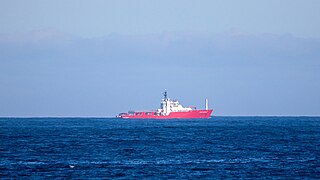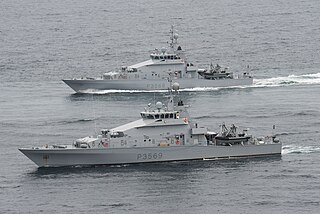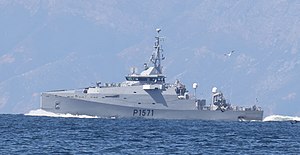
The South African Navy (SA Navy) is the naval warfare branch of the South African National Defence Force.

A patrol boat is a relatively small naval vessel generally designed for coastal defence, border security, or law enforcement. There are many designs for patrol boats, and they generally range in size. They may be operated by a nation's navy, coast guard, police, or customs, and may be intended for marine, estuarine, or river environments.

The Sarah Baartman is a South African environmental protection vessel—of the Damen Offshore Patrol Vessel 8313 class. The Sarah Baartman was commissioned on 10 January 2005. Named after Khoikhoi woman, Sarah Baartman, she was built by Damen Group, of the Netherlands, at one of its Romanian shipyards, and was designed to be capable of patrolling South Africa's entire EEZ, including the area around the southerly Prince Edward Islands.

The South African National Defence Force (SANDF) comprises the armed forces of South Africa. The commander of the SANDF is appointed by the President of South Africa from one of the armed services. They are in turn accountable to the Minister of Defence and Military Veterans of the Defence Department.

SAS Spioenkop (F147) is the third of four Valour-class frigates for the South African Navy built by the European South African Corvette Consortium. She was named by Ms Thandi Modise, the then Chairperson of the Portfolio Committee on Defence, in Hamburg, Germany, on 4 June 2003.

SAS Mendi (F148) is the last of four Valour-class frigates built for the South African Navy by the European South African Corvette Consortium and entered service in March 2007. SAS Mendi was named by Mrs Helena Retief, wife of the (then) Chief of the Navy Vice Admiral Johan Retief.

The Protector-class offshore patrol vessel is a ship class of two offshore patrol vessel (OPVs) operated by the Royal New Zealand Navy (RNZN) since 2010. The ships are named HMNZS Otago and HMNZS Wellington.

The Lake-class inshore patrol vessel is a ship class of inshore patrol vessels (IPVs) of the Royal New Zealand Navy (RNZN) and planned for the Irish Naval Service which replaced the RNZN's Moa-class patrol boats in 2007–2008. All four vessels are named after New Zealand lakes.

Project Protector was a Royal New Zealand Navy (RNZN) procurement project that was undertaken during the 2000s. At the start of the decade, the New Zealand government tasked the New Zealand Defence Force to develop an equal combat, peacekeeping, and disaster relief capability, in which the RNZN was to focus on conducting sealift operations and patrols of the Economic Exclusion Zone. A series of reviews found that the RNZN was lacking in these capabilities, and Project Protector was established to acquire three new ship types: a single multi-role sealift ship, two offshore patrol vessels, and four inshore patrol vessels. After a two-year information-gathering and tender process, an Australian company, Tenix Defence, was selected as the primary contractor.

The Warrior-class strike craft are in service with the South African Navy, with the design being a modified Sa'ar 4 (Reshef)-class fast attack craft. The class was initially known as the Minister class as all the boats were named after South African Ministers of Defence, before being renamed Warrior-class after 1994. The strike craft flotilla was known as SAS Scorpion.

The Arafura class is a class of offshore patrol vessels being built for the Royal Australian Navy (RAN). Initially proposed in the 2009 Defence White Paper and marked as procurement project SEA 1180, it was originally planned that 20 Offshore Combatant Vessels (OCV) would replace 26 vessels across four separate ship classes: the Armidale-class patrol boats, the Huon-class minehunters, the Leeuwin-class survey vessels, and the Paluma-class survey motor launches. Although having a common design, the ships would use a modular mission payload system to fulfill specific roles; primarily border patrol, mine warfare, and hydrographic survey. The 2013 Defence White Paper committed to the OCV project as a long-term goal, but opted in the short term for an accelerated procurement of an existing design to replace the Armidales, and life-extension refits for the other types. This resulted in the Offshore Patrol Vessel (OPV) project and the number of vessels reduced to 12. However, this was further increased to 14 when 2 further Mine Counter Measures variants were proposed under SEA 1905.
The Falaj 2 class are patrol boats of the United Arab Emirates Navy classified as stealth inshore patrol vessels (IPVs).
Naval Base Durban in Durban harbour is a naval base of the South African Navy, situated on Salisbury Island, which is now joined to the mainland through land reclamation.

SAS Isaac Dyobha was a Warrior-class strike craft of the South African Navy.

SAS Galeshewe was a Warrior-class strike craft of the South African Navy, configured as an Offshore Patrol Vessel before being decommissioned in 2020.
The Damen Group has designed and sold the Damen Stan Patrol 3307 -- part of its family of Damen Stan Patrol vessels of different sizes.

The Tun Fatimah class is an offshore patrol vessel built by the Malaysian company THHE-Destini with the assistance of Damen company from the Netherlands based on the design of the Damen 1800-class OPV vessel. THHE-Destini is a joint venture between two local company which is THHE and the Bagan Datuk-class patrol vessel builder, Destini Berhad. The class is also known as the Damen 1800-class offshore patrol vessel and the class changed names after the first ship of the class, KM Tun Fatimah. A total of three ships of this class are planned to be built.

The Yarmook-class corvette is a class of corvettes in service with the Pakistan Navy. The class is primarily based on Damen Group's Offshore Patrol Vessel (OPV) 1900. The primary role of the class is to patrol the sea area.
The South African defence industry is the most advanced in Africa and one of the most advanced and largest in the world with over 20 defence companies. The defence industry provides weapons and equipment to the South African National Defence Force (SANDF) and for export customers. The South African defence industry develops weapons and combat systems such as rifles, armored fighting vehicles, tanks, artillery, military aircraft, navy ships and missiles.














